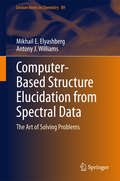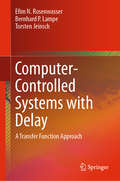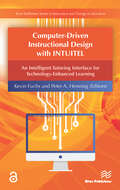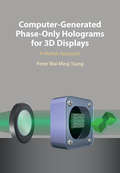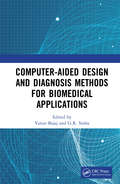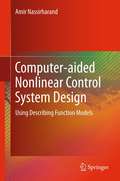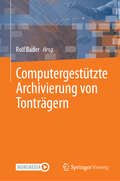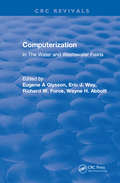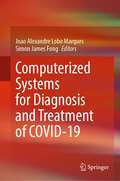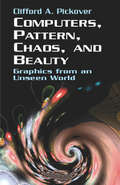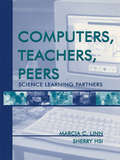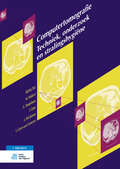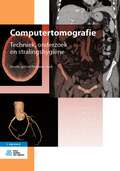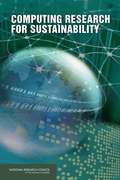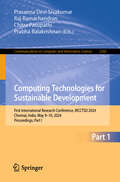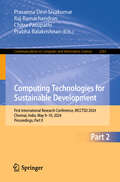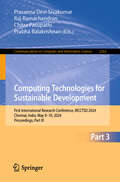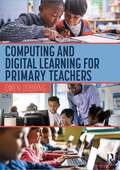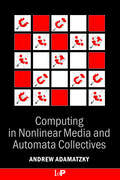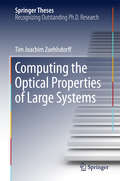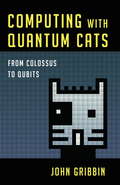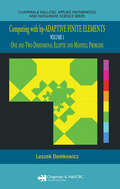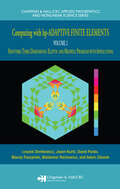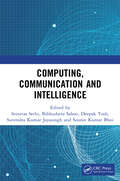- Table View
- List View
Computer-Based Structure Elucidation from Spectral Data: The Art of Solving Problems (Lecture Notes in Chemistry #89)
by Antony J. Williams Mikhail E. ElyashbergHere, the authors introduce readers to solving molecular structure elucidation problems using the expert system ACD/Structure Elucidator. They explain in detail the concepts of the Computer-Assisted Structure Elucidation (CASE) approach and point out the crucial role of understanding the axiomatic nature of the data used to deduce the structure. Aspects covered include the main blocks of the expert system and essential features of the mathematical algorithms used. Graduate and PhD students as well as practicing chemists are provided with a detailed explanation of the various practical approaches depending on available spectral data peculiarities and the complexity of the unknown structure. This is supported by a large number of real-world completed examples, most of which are related to the structure elucidation of natural product molecules containing unusual skeletons. Dedicated software and further supplementary material are available at www. acdlabs. com/TeachingSE.
Computer-Controlled Systems with Delay: A Transfer Function Approach
by Efim N. Rosenwasser Bernhard P. Lampe Torsten JeinschComputer-Controlled Systems with Delay is a systematic study of the problems of analysis and synthesis for multidimensional sampled-data (SD) systems with delay. It is based on the frequency polynomial method, in which the concept of a parametric transfer matrix (PTM) plays a key role. Until now, no alternative general methods have been available to solve the above problems. The text is divided into three parts: background information from the theory of polynomial and rational matrices, helps the reader to acquire the basic understanding necessary to use the main content of the book without addressing additional sources; methods for the mathematical description of multidimensional SD systems with delay, based on the concept of the PTM; and optimization methods for multidimensional SD systems with delay, including H2 and L2 optimization as well as H2 optimization for colored input signals. The monograph is completed by three appendices. An algorithm for constructing the set of pathological sampling periods for a continuous SISO object with delay is provided first. MATLAB®-toolbox algorithms representing methods described in the book and application examples for selected optimization problems are given in the second. A solution to the problem of guaranteeing the required performance in a class of stochastic disturbances for SD systems with delay is considered in the third. Computer-Controlled Systems with Delay is intended for engineers, scientists and teachers working in modern control theory. It will also benefit post-graduate students taking courses in related disciplines. The book continues the description of the authors’ research results on developing methods for SD systems theory which are based on the PTM concept and published in the monographs Computer Controlled Systems and Multivariable Computer-controlled Systems.
Computer-Driven Instructional Design with INTUITEL
by Kevin Fuchs Peter A. HenningINTUITEL is a research project that was co-financed by the European Commission with the aim to advance state-of-the-art e-learning systems via addition of guidance and feedback for learners. Through a combination of pedagogical knowledge, measured learning progress and a broad range of environmental and background data, INTUITEL systems will provide guidance towards an optimal learning pathway. This allows INTUITEL-enabled learning management systems to offer learners automated, personalised learning support so far only provided by human tutors INTUITEL is - in the first place - a design pattern for the creation of adaptive e-learning systems. It focuses on the reusability of existing learning material and especially the annotation with semantic meta data. INTUITEL introduces a novel approach that describes learning material as well as didactic and pedagogical meta knowledge by the use of ontologies. Learning recommendations are inferred from these ontologies during runtime. This way INTUITEL solves a common problem in the field of adaptive systems: it is not restricted to a certain field. Any content from any domain can be annotated. The INTUITEL research team also developed a prototype system. Both the theoretical foundations and how to implement your own INTUITEL system are discussed in this book.
Computer-Generated Phase-Only Holograms for 3D Displays: A Matlab Approach
by Peter Wai Tsang'Phase-only Fresnel holograms,' which can be displayed on a single SLM without the need for lenses or complicated optical accessories, substantially simplifies 3-D holographic display systems. Exploring essential concepts, theories, and formulations of these phase-only Fresnel holograms, this book provides comprehensive coverage of modern methods for generating such holograms, which pave the way for commercial products such as compact holographic projectors, heads-up displays, and data security enhancement. Relevant MATLAB codes are provided for readers to implement and evaluate the theories and formulations of different methods, and can be used as a quick start framework for further research and development. This is a crucial and up-to-date treatment of phase-only Fresnel holograms for students and researchers in electrical and electronic engineering, computer science/engineering, applied physics, information technology, and multimedia technology, as well as engineers and scientists in industry developing new products on 3-D displays and holographic projection.
Computer-aided Design and Diagnosis Methods for Biomedical Applications
by Varun Bajaj and G.R. SinhaComputer-aided design (CAD) plays a key role in improving biomedical systems for various applications. It also helps in the detection, identification, predication, analysis, and classification of diseases, in the management of chronic conditions, and in the delivery of health services. This book discusses the uses of CAD to solve real-world problems and challenges in biomedical systems with the help of appropriate case studies and research simulation results. Aiming to overcome the gap between CAD and biomedical science, it describes behaviors, concepts, fundamentals, principles, case studies, and future directions for research, including the automatic identification of related disorders using CAD. Features: Proposes CAD for the study of biomedical signals to understand physiology and to improve healthcare systems’ ability to diagnose and identify health disorders. Presents concepts of CAD for biomedical modalities in different disorders. Discusses design and simulation examples, issues, and challenges. Illustrates bio-potential signals and their appropriate use in studying different disorders. Includes case studies, practical examples, and research directions. Computer-Aided Design and Diagnosis Methods for Biometrical Applications is aimed at researchers, graduate students in biomedical engineering, image processing, biomedical technology, medical imaging, and health informatics.
Computer-aided Nonlinear Control System Design: Using Describing Function Models
by Amir NassirharandA systematic computer-aided approach provides a versatile setting for the control engineer to overcome the complications of controller design for highly nonlinear systems. Computer-aided Nonlinear Control System Design provides such an approach based on the use of describing functions. The text deals with a large class of nonlinear systems without restrictions on the system order, the number of inputs and/or outputs or the number, type or arrangement of nonlinear terms. The strongly software-oriented methods detailed facilitate fulfillment of tight performance requirements and help the designer to think in purely nonlinear terms, avoiding the expedient of linearization which can impose substantial and unrealistic model limitations and drive up the cost of the final product. Design procedures are presented in a step-by-step algorithmic format each step being a functional unit with outputs that drive the other steps. This procedure may be easily implemented on a digital computer with example problems from mechatronic and aerospace design being used to demonstrate the techniques discussed. The author's commercial MATLAB®-based environment, available separately from insert URL here, can be used to create simulations showing the results of using the computer-aided control system design ideas characterized in the text. Academic researchers and graduate students studying nonlinear control systems and control engineers dealing with nonlinear plant, particularly mechatronic or aerospace systems will find Computer-aided Nonlinear Control System Design to be of great practical assistance adding to their toolbox of techniques for dealing with system nonlinearities. A basic knowledge of calculus, nonlinear analysis and software engineering will enable the reader to get the best from this book.
Computergestützte Archivierung von Tonträgern
by Rolf BaderDie Zukunft der Musikarchivierung und der Suchmaschinen liegt im Deep Learning und in Big Data. Algorithmen zum Abrufen von Musikinformationen analysieren automatisch musikalische Merkmale wie Klangfarbe, Melodie, Rhythmus oder musikalische Form, und künstliche Intelligenz sortiert und verknüpft diese Merkmale dann. Auf dem ersten International Symposium on Computational Ethnomusicological Archiving, das vom 9. bis 11. November 2017 am Institut für Systematische Musikwissenschaft in Hamburg stattfand, wurde ein neuer Standard für Computational Phonogram Archiving als interdisziplinärer Ansatz diskutiert. Ethnomusikologen, Musik- und Computerwissenschaftler, Systematische Musikwissenschaftler sowie Musikarchivare, Komponisten und Musiker stellten Werkzeuge, Methoden und Plattformen vor und tauschten Erfahrungen aus der Feldforschung und Archivierung in den Bereichen musikalische Akustik, Informatik, Musiktheorie sowie Musikspeicherung, -wiedergabe und Metadaten aus. Der Standard Computational Phonogram Archiving ist auch auf dem Musikmarkt als Suchmaschine für Musikkonsumenten sehr gefragt. Dieses Buch bietet einen umfassenden Überblick über das Gebiet, geschrieben von führenden Forschern aus aller Welt.
Computerization: In The Water and Wastewater Fields
by Eugene A GlyssonThis book includes information regarding, utility rate studies, Water and sewer network analysis and mapping and design. Microcomputer are finding an increasing role in the operation of water and wastewater plants. Their typical initial uses are in word processing, report writing, correspondence, inventory control and general book keeping functions.
Computerized Systems for Diagnosis and Treatment of COVID-19
by Simon James Fong Joao Alexandre Lobo MarquesThis book describes the application of signal and image processing technologies, artificial intelligence, and machine learning techniques to support Covid-19 diagnosis and treatment. The book focuses on two main applications: critical diagnosis requiring high precision and speed, and treatment of symptoms, including those affecting the cardiovascular and neurological systems.The areas discussed in this book range from signal processing, time series analysis, and image segmentation to detection and classification. Technical approaches include deep learning, transfer learning, transformers, AutoML, and other machine learning techniques that can be considered not only for Covid-19 issues but also for different medical applications, with slight adjustments to the problem under study.The Covid-19 pandemic has impacted the entire world and changed how societies and individuals interact. Due to the high infection and mortality rates, and the multiple consequences of the virus infection in the human body, the challenges were vast and enormous. These necessitated the integration of different disciplines to address the problems. As a global response, researchers across academia and industry made several developments to provide computational solutions to support epidemiologic, managerial, and health/medical decisions. To that end, this book provides state-of-the-art information on the most advanced solutions.
Computers, Pattern, Chaos and Beauty
by Clifford A. PickoverCombining fractal theory with computer art, this book introduces a creative use of computers. It describes graphic methods for detecting patterns in complicated data and illustrates simple techniques for visualizing chaotic behavior. "Beautiful." -- Martin Gardner, Scientific American. Over 275 illustrations, 29 in color.
Computers, Teachers, Peers: Science Learning Partners
by Marcia C. Linn Sherry HsiLinn and Hsi show how computers, teachers, and peers can serve as learning partners--helping students build on their ideas and become lifelong science learners. They invite everyone interested in improving science education to build on their experiences, share insights on the Internet, and create instruction. Computers, Teachers, Peers: * offers case studies to bring the ideas of students learning science to life. *Join Sasha, Chris, Pat, and Lee as they try to make sense of experiments using computers to display data in real time;* * provides principles to help teachers improve their instruction, use technology better, and inspire more students to love science. *Find out how to use visualization tools, online discussion, and more to make science relevant;* * gives researchers and instructional designers a model for effective research and curriculum design. *Linn and Hsi report that the partnership approach to research resulted in a 400% increase in student understanding of science;* * helps schools develop technology plans that continuously improve science instruction. *Find out how schools can design better ways to use technology for learning;* * describes a partnership inquiry process where science teachers, science education researchers, discipline specialists, and technologists consider each others' perspectives and jointly design instruction. *Boys and girls are equally successful in the resulting science courses;* and * features practical tools for learning and instruction, including "Points to Ponder"--to encourage reflection on the ideas in each chapter (partnership groups or classes might use the points as discussion starters or assignments), and "Ask Mr. K."--an interview, in each chapter, with the classroom teacher who was a founding member of the CLP partnership (in these interviews Mr. K. adds insights from his own classroom experiences). This book is supplemented by a CD-ROM (included in each copy) and a Web site (www.clp.berkeley.edu) with the Computers as Learning Partners curriculum, lesson plans, a Quicktime virtual reality visit to the classroom, copies of assessments, opportunities to join partnerships, and more. For readers who wish for more information, Related Readings are cited, including works by authors mentioned in each chapter. Additional works by other authors who inspired the authors appear in the bibliography, on the website, and on the CD-ROM. An annotated bibliography of papers by the members of the CLP partnership also appears at the website and on the CD-ROM.
Computertomografie
by Tom Dam José Dol-Jansen Sija Geers-van Gemeren Marcel Hakkert Gert TempelmanComputertomografie maakt deel uit van de boekenserie Medische Beeldvorming en Radiotherapie. De uitgave van deze boeken is oorspronkelijk ontstaan vanuit een gezamenlijk project, genaamd Samenwerkingsverband Leermiddelen, en de redacties in samenwerking met auteurs uit het werkveld.Dit boek is een vervolg op, en afgeleid van de boeken Techniek in de radiologie en radiodiagnostisch onderzoek, Vanaf 2010 zijn deze boeken vervangen door drie losse delen, die sterk zijn uitgebreid en geacutaliseerd: Computertomografie, Magenetic Resonance Imaging* en Radiologie*Computertomografie bestaat uit drie onderdelen: deel 1 Techniek, deel 2 Onderzoek en deel 3 Stralingshygiëne. Na het behandelen van de basisprincipes en technieken van de CT is er een uitgebreide beschrijving van de ontwikkeling van axiaal naar spiraal en van single slice nar multislice CT, automatic exposure control, CT-protocollen, en multislice CT bij kinderen. Speciale aandacht is er voor dosisbesparende maatregelen.Behalve voor MBB'ers (Medische Beeldvormings- en Bestralingsdeskundigen) in opleiding is Computertomografie ook bij uitstek geschikt voor MBB'ers werkzaam in de radiologie, nucleaire geneeskunde en radiotherapie.Het boek is ook een goede introductie en naslagwerk voor medische specialisten en klnisch fysici.(*in voorbereiding)
Computertomografie: Techniek, onderzoek en stralingshygiëne (Medische beeldvorming en radiotherapie)
by M. Hakkert G. Tempelman T. DamDit boek beschrijft de technische principes van een CT-scanner, de uitvoering van een CT-onderzoek en de daarbij geldende stralingshygiënische aandachtspunten. De hoofdstukken zijn geschreven door experts uit diverse bij het vak betrokken disciplines: MBB’er CT, radioloog, applicatiespecialist CT, docent MBRT en stralingsdeskundige.Bij elk hoofdstuk zijn online toetsvragen beschikbaar.Computertomografie maakt deel uit van de serie Medische beeldvorming en radiotherapie. Het boek is als volgt ingedeeld: deel 1 Techniek, deel 2 Onderzoek en deel 3 Stralingshygiëne. In deze geheel vernieuwde uitgave zijn belangrijke onderwerpen als spectrale CT/dual energy en iteratieve reconstructie toegevoegd. De hoofdstukken in het eerste deel zijn aangepast aan de techniek van de huidige moderne scanners. De hoofdstukken in het deel Onderzoek zijn geactualiseerd volgens de huidige gangbare inzichten. Naast de vele gangbare CT-onderzoeken van met name thorax en abdomen is er ook veel aandacht voor specialistische onderzoeken, zoals CT-angiografie, cardiac CT en breinperfusie. In het deel Stralingshygiëne staan dosimetrie en dosisbesparing bij computertomografie centraal. Behalve als leerboek voor MBB'ers (medisch beeldvormend en bestralingsdeskundigen) is Computertomografie ook bij uitstek geschikt als naslagwerk voor hen die reeds de (initiële) opleiding hebben afgesloten. Daarnaast is de uitgave een goede introductie voor radiologen en klinisch fysici in opleiding.
Computing Research for Sustainability
by Committee on Computing Research for Environmental Societal SustainabilityA broad and growing literature describes the deep and multidisciplinary nature of the sustainability challenges faced by the United States and the world. Despite the profound technical challenges involved, sustainability is not, at its root, a technical problem, nor will merely technical solutions be sufficient. Instead, deep economic, political, and cultural adjustments will ultimately be required, along with a major, long-term commitment in each sphere to deploy the requisite technical solutions at scale. Nevertheless, technological advances and enablers have a clear role in supporting such change, and information technology (IT) is a natural bridge between technical and social solutions because it can offer improved communication and transparency for fostering the necessary economic, political, and cultural adjustments. Moreover, IT is at the heart of nearly every large-scale socioeconomic system-including systems for finance, manufacturing, and the generation and distribution of energy-and so sustainability-focused changes in those systems are inextricably linked with advances in IT. The focus of Computing Research for Sustainability is "greening through IT," the application of computing to promote sustainability broadly. The aim of this report is twofold: to shine a spotlight on areas where IT innovation and computer science (CS) research can help, and to urge the computing research community to bring its approaches and methodologies to bear on these pressing global challenges. Computing Research for Sustainability focuses on addressing medium- and long-term challenges in a way that would have significant, measurable impact. The findings and recommended principles of the Committee on Computing Research for Environmental and Societal Sustainability concern four areas: (1) the relevance of IT and CS to sustainability; (2) the value of the CS approach to problem solving, particularly as it pertains to sustainability challenges; (3) key CS research areas; and (4) strategy and pragmatic approaches for CS research on sustainability.
Computing Technologies for Sustainable Development: First International Research Conference, IRCCTSD 2024, Chennai, India, May 9–10, 2024, Proceedings, Part I (Communications in Computer and Information Science #2360)
by Prasanna Devi Sivakumar Raj Ramachandran Chitra Pasupathi Prabha BalakrishnanThis book constitutes the refereed proceedings of the First International Research Conference on Computing Technologies for Sustainable Development, IRCCTSD 2024, held in Chennai, India, during May 9–10, 2024. The 65 full papers and 14 short papers presented here were carefully selected and reviewed from 264 submissions. These papers have been organized in the following topical sections: Part I: innovations in precision agriculture techniques and strategies for enhancing agriculture production; classification and prediction analysis in healthcare; animal welfare; and innovations in diagnostics. Part II: video and image processing for security analysis; innovations for smart cities; sustainable practices in e-commerce: challenges and trends. Part III: environmental analysis and protection; inclusive communication techniques; AI for text, audio, image and video processing; and application of AI for education.
Computing Technologies for Sustainable Development: First International Research Conference, IRCCTSD 2024, Chennai, India, May 9–10, 2024, Proceedings, Part II (Communications in Computer and Information Science #2361)
by Prasanna Devi Sivakumar Raj Ramachandran Chitra Pasupathi Prabha BalakrishnanThis book constitutes the refereed proceedings of the First International Research Conference on Computing Technologies for Sustainable Development, IRCCTSD 2024, held in Chennai, India, during May 9–10, 2024. The 65 full papers and 14 short papers presented here were carefully selected and reviewed from 264 submissions. These papers have been organized in the following topical sections: Part I : innovations in precision agriculture techniques and strategies for enhancing agriculture production; classification and prediction analysis in healthcare; animal welfare; and innovations in diagnostics. Part II : video and image processing for security analysis; innovations for smart cities; sustainable practices in e-commerce: challenges and trends. Part III : environmental analysis and protection; inclusive communication techniques; AI for text, audio, image and video processing; and application of AI for education.
Computing Technologies for Sustainable Development: First International Research Conference, IRCCTSD 2024, Chennai, India, May 9–10, 2024, Proceedings, Part III (Communications in Computer and Information Science #2362)
by Prasanna Devi Sivakumar Raj Ramachandran Chitra Pasupathi Prabha BalakrishnanThis book constitutes the refereed proceedings of the First International Research Conference on Computing Technologies for Sustainable Development, IRCCTSD 2024, held in Chennai, India, during May 9–10, 2024. The 65 full papers and 14 short papers presented here were carefully selected and reviewed from 264 submissions. These papers have been organized in the following topical sections: Part I: innovations in precision agriculture techniques and strategies for enhancing agriculture production; classification and prediction analysis in healthcare; animal welfare; and innovations in diagnostics. Part II: video and image processing for security analysis; innovations for smart cities; sustainable practices in e-commerce: challenges and trends. Part III: environmental analysis and protection; inclusive communication techniques; AI for text, audio, image and video processing; and application of AI for education.
Computing and Digital Learning for Primary Teachers
by Owen DobbingWhether they are new or experienced, teachers are expected to plan and deliver high-quality computing lessons to their pupils. Computing and Digital Learning for Primary Teachers provides an accessible introduction to teaching computing effectively and for deeper understanding in the primary classroom.Filled with practical resources to support lesson design, long-term planning, and assessment, readers will benefit from building their subject knowledge and learning to create engaging lessons for their pupils. Chapters explore: Supporting computational thinking and problem-solving to teach our pupils how to solve problems logically and systematically. Developing pupils’ digital literacy and use of IT, creating exciting opportunities for children’s digital self-expression through film, animation, and 3D design. Managing technology in our schools, such as setting up and maintaining a virtual learning environment (VLE). Cross-curriculum links with STEAM and engineering, allowing children to solve real-world problems by combining their digital literacy with their knowledge of maths, science, and technology. Cost-effective and accessible ways of introducing physical computing and robotics to children. Safe and responsible uses of artificial intelligence (AI) in our primary schools. This essential resource provides a highly practical guide to delivering effective computing lessons in the primary classroom and is a must read for anyone who wishes to become a more confident and knowledgeable computing teacher.
Computing for Biologists
by Ran Libeskind-Hadas Eliot BushComputing is revolutionizing the practice of biology. This book, which assumes no prior computing experience, provides students with the tools to write their own Python programs and to understand fundamental concepts in computational biology and bioinformatics. Each major part of the book begins with a compelling biological question, followed by the algorithmic ideas and programming tools necessary to explore it: the origins of pathogenicity are examined using gene finding, the evolutionary history of sex determination systems is studied using sequence alignment, and the origin of modern humans is addressed using phylogenetic methods. In addition to providing general programming skills, this book explores the design of efficient algorithms, simulation, NP-hardness, and the maximum likelihood method, among other key concepts and methods. Easy-to-read and designed to equip students with the skills to write programs for solving a range of biological problems, the book is accompanied by numerous programming exercises, available at www. cs. hmc. edu/CFB.
Computing in Nonlinear Media and Automata Collectives
by Andrew AdamatzkyComputing in Nonlinear Media and Automata Collectives presents an account of new ways to design massively parallel computing devices in advanced mathematical models, such as cellular automata and lattice swarms, from unconventional materials, including chemical solutions, bio-polymers, and excitable media.
Computing the Optical Properties of Large Systems (Springer Theses)
by Tim Joachim ZuehlsdorffThis work addresses the computation of excited-state properties of systems containing thousands of atoms. To achieve this, the author combines the linear response formulation of time-dependent density functional theory (TDDFT) with linear-scaling techniques known from ground-state density-functional theory. This extends the range of TDDFT, which on its own cannot tackle many of the large and interesting systems in materials science and computational biology. The strengths of the approach developed in this work are demonstrated on a number of problems involving large-scale systems, including exciton coupling in the Fenna-Matthews-Olson complex and the investigation of low-lying excitations in doped p-terphenyl organic crystals.
Computing with Quantum Cats
by John GribbinA mind-blowing glimpse into the near future, where quantum computing will have world-transforming effects.The quantum computer is no longer the stuff of science fiction. Pioneering physicists are on the brink of unlocking a new quantum universe which provides a better representation of reality than our everyday experiences and common sense ever could. The birth of quantum computers - which, like Schrödinger's famous "dead and alive" cat, rely on entities like electrons, photons, or atoms existing in two states at the same time - is set to turn the computing world on its head.In his fascinating study of this cutting-edge technology, John Gribbin updates his previous views on the nature of quantum reality, arguing for a universe of many parallel worlds where "everything is real." Looking back to Alan Turing's work on the Enigma machine and the first electronic computer, Gribbin explains how quantum theory developed to make quantum computers work in practice as well as in principle. He takes us beyond the arena of theoretical physics to explore their practical applications - from machines which learn through "intuition" and trial and error to unhackable laptops and smartphones. And he investigates the potential for this extraordinary science to create a world where communication occurs faster than light and teleportation is possible.This is an exciting insider's look at the new frontier of computer science and its revolutionary implications.
Computing with hp-ADAPTIVE FINITE ELEMENTS: Volume 1 One and Two Dimensional Elliptic and Maxwell Problems (Chapman & Hall/CRC Applied Mathematics & Nonlinear Science)
by Leszek DemkowiczOffering the only existing finite element (FE) codes for Maxwell equations that support hp refinements on irregular meshes, Computing with hp-ADAPTIVE FINITE ELEMENTS: Volume 1. One- and Two-Dimensional Elliptic and Maxwell Problems presents 1D and 2D codes and automatic hp adaptivity. This self-contained source discusses the theory and implementat
Computing with hp-ADAPTIVE FINITE ELEMENTS: Volume II Frontiers: Three Dimensional Elliptic and Maxwell Problems with Applications (Chapman & Hall/CRC Applied Mathematics & Nonlinear Science)
by David Pardo Leszek Demkowicz Maciej Paszynski Jason Kurtz Waldemar Rachowicz Adam ZdunekWith a focus on 1D and 2D problems, the first volume of Computing with hp-ADAPTIVE FINITE ELEMENTS prepared readers for the concepts and logic governing 3D code and implementation. Taking the next step in hp technology, Volume II Frontiers: Three-Dimensional Elliptic and Maxwell Problems with Applications presents the theoretical foundations of the
Computing, Communication and Intelligence
by Srinivas Sethi Bibhudatta Sahoo Deepak Tosh Suvendra Kumar Jayasingh Sourav Kumar BhoiThe International Conference on Cutting-edge Technology in Computing, Communications, and Intelligence- (ICCTCCI-2024) focuses on the application of smart technology and materials for smarter industrial production. The ICCTCCI-2024 provides common platform for presentation of original research findings, exchange of ideas and dissemination of innovative, practical development experiences in different aspects and fields of industry. It also focuses on the event organized with the objective of bringing together academicians, scientists, researchers from industry, research scholars, and students working in different industrial domains and applied applications.
